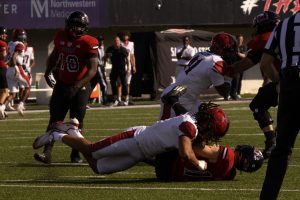Badgley: Bats need to change
April 20, 2005
Mark Badgley didn’t know what hit him. When he opened his eyes, NIU baseball coach Ed Mathey and the team trainer were asking for his last name and what year it was.
What the NIU pitcher did not realize was he had just been struck in the head by a line drive.
“I don’t even remember the ball coming at me,” Badgley said. “I didn’t even know where I was. I thought I was waking up in the morning and getting ready to go to the game.”
In the second inning of NIU’s March 30 game at Bradley, Badgley, a junior, was knocked unconscious for about one minute. He didn’t feel the pain at first, but once he tried to move, the throbbing began. Doctors determined he suffered a concussion and a skull fracture.
But the McHenry native was fortunate. He did not join the list of 17 other amateur and professional baseball pitchers players who were killed by batted balls between 1991 and 2001.
Cases like Badgley’s have revived a decades-old debate – should college baseball switch to wooden bats?
Testing and changes
In September 1999, the NCAA Rules Committee addressed some of these concerns by re-evaluating its testing process for bats.
Maximums for metal-bat barrels were reduced in diameter from 2.75 to 2.625 inches. The unit difference between length and weight was also changed from five units to three. In other words, a 35-inch long bat is required to weigh at least 32 ounces instead of the previous 30 ounces.
The changes in bat specifications resulted from the Ball Exit Speed Ratio. During BESR, a ball is thrown and a bat is swung at the same speed (80 mph) and a mathematical formula determines how fast the ball comes off the bat.
The Rules Committee originally recommended 94 mph as the maximum exit speed during metal bat testing. But, the NCAA decided to go with a higher BESR equivalent of 97 mph.
“That’s the advantage of metal bats; it’s all about bat speed,” said Anthony Holman, the Illinois High School Association assistant executive director. “Players get quicker through the strike zone. We could soften the ball or something. But purists will say it takes away from the integrity of the game.”
Possible switch?
One thing keeping the NCAA from changing completely to wooden bats is contracts with manufacturers, Mathey said.
“The NCAA allows the American Baseball Coaches Association to initiate changes,” Mathey said. “But lots of programs are being reimbursed by manufacturers. So coaches are less likely to vote for changing to wood.”
Easton is one company that has substantial investments in the sport with a total of 91 college baseball programs under contract.
Price and durability have also been cited as issues preventing a switch to wood.
“Part of it is economics,” Holman said. “Aluminum bats are far more expensive. But when kids aren’t used to using wood bats, [they’re] easier to break. Schools can’t afford to keep buying bats.”
The MAC could switch to wood through a voting process, MAC Assistant Commissioner Paul Palian said. The coaches can make recommendations at their annual business meetings. The recommendations would then go through the conference’s athletic directors, a joint committee and be voted on by the MAC council presidents.
Return to normalcy
Three weeks after the incident, Badgley has returned to classes at NIU and plans on rejoining the team next year. But the repercussions are still being felt. Besides weekly appointments with a neurologist to make sure no memory loss has occurred, he requires a CAT scan every two weeks.
“Before all this happened, I would’ve said no to switching to wood,” Badgley said “But now I’ve changed my mind. I wouldn’t want this to happen to anyone else.”






